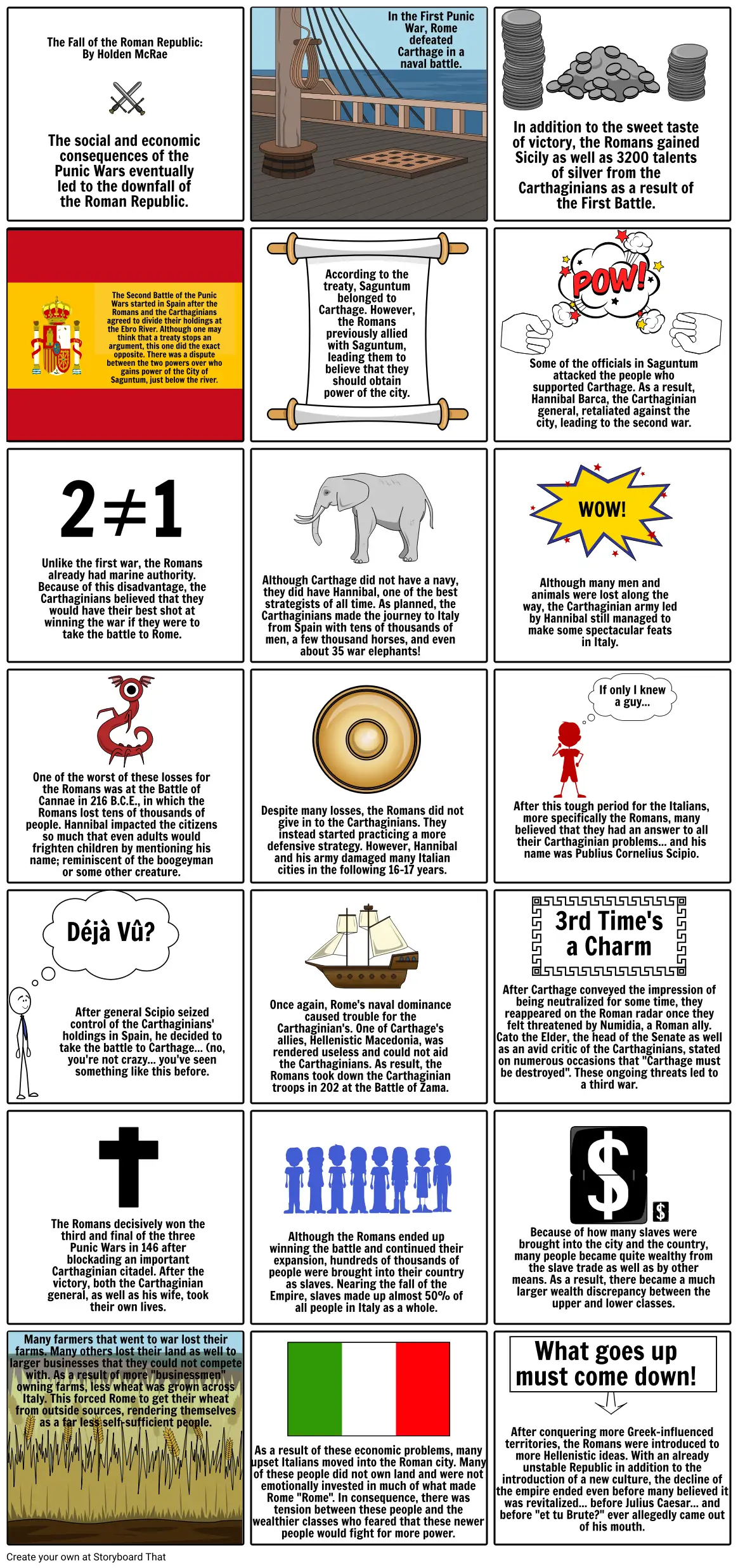The Downfall of the Roman Republic

Storyboard Text
- The social and economic consequences of the Punic Wars eventually led to the downfall of the Roman Republic.
- The Fall of the Roman Republic: By Holden McRae
- In the First Punic War, Rome defeated Carthage in a naval battle.
- In addition to the sweet taste of victory, the Romans gained Sicily as well as 3200 talents of silver from the Carthaginians as a result of the First Battle.
- The Second Battle of the Punic Wars started in Spain after the Romans and the Carthaginians agreed to divide their holdings at the Ebro River. Although one may think that a treaty stops an argument, this one did the exact opposite. There was a dispute between the two powers over who gains power of the City of Saguntum, just below the river.
- According to the treaty, Saguntum belonged to Carthage. However, the Romans previously allied with Saguntum, leading them to believe that they should obtain power of the city.
- Some of the officials in Saguntum attacked the people who supported Carthage. As a result, Hannibal Barca, the Carthaginian general, retaliated against the city, leading to the second war.
- Unlike the first war, the Romans already had marine authority. Because of this disadvantage, the Carthaginians believed that they would have their best shot at winning the war if they were to take the battle to Rome.
- 2≠1
- Although Carthage did not have a navy, they did have Hannibal, one of the best strategists of all time. As planned, the Carthaginians made the journey to Italy from Spain with tens of thousands of men, a few thousand horses, and even about 35 war elephants!
- Although many men and animals were lost along the way, the Carthaginian army led by Hannibal still managed to make some spectacular feats in Italy.
- WOW!
- One of the worst of these losses for the Romans was at the Battle of Cannae in 216 B.C.E., in which the Romans lost tens of thousands of people. Hannibal impacted the citizens so much that even adults would frighten children by mentioning his name; reminiscent of the boogeyman or some other creature.
- Despite many losses, the Romans did not give in to the Carthaginians. They instead started practicing a more defensive strategy. However, Hannibal and his army damaged many Italian cities in the following 16-17 years.
- After this tough period for the Italians, more specifically the Romans, many believed that they had an answer to all their Carthaginian problems... and his name was Publius Cornelius Scipio.
- If only I knew a guy...
- Déjà Vû?
- After general Scipio seized control of the Carthaginians' holdings in Spain, he decided to take the battle to Carthage... (no, you're not crazy... you've seen something like this before.
- Once again, Rome's naval dominance caused trouble for the Carthaginian's. One of Carthage's allies, Hellenistic Macedonia, was rendered useless and could not aid the Carthaginians. As result, the Romans took down the Carthaginian troops in 202 at the Battle of Zama.
- After Carthage conveyed the impression of being neutralized for some time, they reappeared on the Roman radar once they felt threatened by Numidia, a Roman ally. Cato the Elder, the head of the Senate as well as an avid critic of the Carthaginians, stated on numerous occasions that "Carthage must be destroyed". These ongoing threats led to a third war.
- 3rd Time's a Charm
- The Romans decisively won the third and final of the three Punic Wars in 146 after blockading an important Carthaginian citadel. After the victory, both the Carthaginian general, as well as his wife, took their own lives.
- Although the Romans ended up winning the battle and continued their expansion, hundreds of thousands of people were brought into their country as slaves. Nearing the fall of the Empire, slaves made up almost 50% of all people in Italy as a whole.
- Because of how many slaves were brought into the city and the country, many people became quite wealthy from the slave trade as well as by other means. As a result, there became a much larger wealth discrepancy between the upper and lower classes.
- Many farmers that went to war lost their farms. Many others lost their land as well to larger businesses that they could not compete with. As a result of more "businessmen" owning farms, less wheat was grown across Italy. This forced Rome to get their wheat from outside sources, rendering themselves as a far less self-sufficient people.
- As a result of these economic problems, many upset Italians moved into the Roman city. Many of these people did not own land and were not emotionally invested in much of what made Rome "Rome". In consequence, there was tension between these people and the wealthier classes who feared that these newer people would fight for more power.
- After conquering more Greek-influenced territories, the Romans were introduced to more Hellenistic ideas. With an already unstable Republic in addition to the introduction of a new culture, the decline of the empire ended even before many believed it was revitalized... before Julius Caesar... and before "et tu Brute?" ever allegedly came out of his mouth.
- What goes up must come down!
Over 30 Million Storyboards Created
No Downloads, No Credit Card, and No Login Needed to Try!
